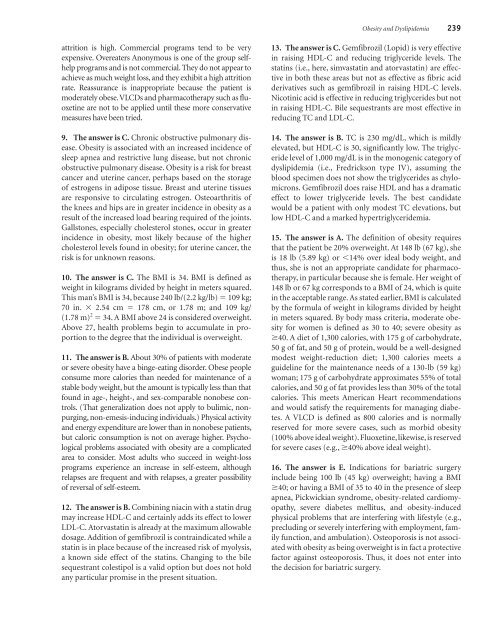NMS Q&A Family Medicine
NMS Q&A Family Medicine
NMS Q&A Family Medicine
- No tags were found...
Create successful ePaper yourself
Turn your PDF publications into a flip-book with our unique Google optimized e-Paper software.
Obesity and Dyslipidemia 239attrition is high. Commercial programs tend to be veryexpensive. Overeaters Anonymous is one of the group selfhelpprograms and is not commercial. They do not appear toachieve as much weight loss, and they exhibit a high attritionrate. Reassurance is inappropriate because the patient ismoderately obese. VLCDs and pharmacotherapy such as fluoxetineare not to be applied until these more conservativemeasures have been tried.9. The answer is C. Chronic obstructive pulmonary disease.Obesity is associated with an increased incidence ofsleep apnea and restrictive lung disease, but not chronicobstructive pulmonary disease. Obesity is a risk for breastcancer and uterine cancer, perhaps based on the storageof estrogens in adipose tissue. Breast and uterine tissuesare responsive to circulating estrogen. Osteoarthritis ofthe knees and hips are in greater incidence in obesity as aresult of the increased load bearing required of the joints.Gallstones, especially cholesterol stones, occur in greaterincidence in obesity, most likely because of the highercholesterol levels found in obesity; for uterine cancer, therisk is for unknown reasons.10. The answer is C. The BMI is 34. BMI is defined asweight in kilograms divided by height in meters squared.This man’s BMI is 34, because 240 lb/(2.2 kg/lb) 109 kg;70 in. 2.54 cm 178 cm, or 1.78 m; and 109 kg/(1.78 m) 2 34. A BMI above 24 is considered overweight.Above 27, health problems begin to accumulate in proportionto the degree that the individual is overweight.11. The answer is B. About 30% of patients with moderateor severe obesity have a binge-eating disorder. Obese peopleconsume more calories than needed for maintenance of astable body weight, but the amount is typically less than thatfound in age-, height-, and sex-comparable nonobese controls.(That generalization does not apply to bulimic, nonpurging,non-emesis-inducing individuals.) Physical activityand energy expenditure are lower than in nonobese patients,but caloric consumption is not on average higher. Psychologicalproblems associated with obesity are a complicatedarea to consider. Most adults who succeed in weight-lossprograms experience an increase in self-esteem, althoughrelapses are frequent and with relapses, a greater possibilityof reversal of self-esteem.12. The answer is B. Combining niacin with a statin drugmay increase HDL-C and certainly adds its effect to lowerLDL-C. Atorvastatin is already at the maximum allowabledosage. Addition of gemfibrozil is contraindicated while astatin is in place because of the increased risk of myolysis,a known side effect of the statins. Changing to the bilesequestrant colestipol is a valid option but does not holdany particular promise in the present situation.13. The answer is C. Gemfibrozil (Lopid) is very effectivein raising HDL-C and reducing triglyceride levels. Thestatins (i.e., here, simvastatin and atorvastatin) are effectivein both these areas but not as effective as fibric acidderivatives such as gemfibrozil in raising HDL-C levels.Nicotinic acid is effective in reducing triglycerides but notin raising HDL-C. Bile sequestrants are most effective inreducing TC and LDL-C.14. The answer is B. TC is 230 mg/dL, which is mildlyelevated, but HDL-C is 30, significantly low. The triglyceridelevel of 1,000 mg/dL is in the monogenic category ofdyslipidemia (i.e., Fredrickson type IV), assuming theblood specimen does not show the triglycerides as chylomicrons.Gemfibrozil does raise HDL and has a dramaticeffect to lower triglyceride levels. The best candidatewould be a patient with only modest TC elevations, butlow HDL-C and a marked hypertriglyceridemia.15. The answer is A. The definition of obesity requiresthat the patient be 20% overweight. At 148 lb (67 kg), sheis 18 lb (5.89 kg) or 14% over ideal body weight, andthus, she is not an appropriate candidate for pharmacotherapy,in particular because she is female. Her weight of148 lb or 67 kg corresponds to a BMI of 24, which is quitein the acceptable range. As stated earlier, BMI is calculatedby the formula of weight in kilograms divided by heightin meters squared. By body mass criteria, moderate obesityfor women is defined as 30 to 40; severe obesity as 40. A diet of 1,300 calories, with 175 g of carbohydrate,50 g of fat, and 50 g of protein, would be a well-designedmodest weight-reduction diet; 1,300 calories meets aguideline for the maintenance needs of a 130-lb (59 kg)woman; 175 g of carbohydrate approximates 55% of totalcalories, and 50 g of fat provides less than 30% of the totalcalories. This meets American Heart recommendationsand would satisfy the requirements for managing diabetes.A VLCD is defined as 800 calories and is normallyreserved for more severe cases, such as morbid obesity(100% above ideal weight). Fluoxetine, likewise, is reservedfor severe cases (e.g., 40% above ideal weight).16. The answer is E. Indications for bariatric surgeryinclude being 100 lb (45 kg) overweight; having a BMI 40; or having a BMI of 35 to 40 in the presence of sleepapnea, Pickwickian syndrome, obesity-related cardiomyopathy,severe diabetes mellitus, and obesity-inducedphysical problems that are interfering with lifestyle (e.g.,precluding or severely interfering with employment, familyfunction, and ambulation). Osteoporosis is not associatedwith obesity as being overweight is in fact a protectivefactor against osteoporosis. Thus, it does not enter intothe decision for bariatric surgery.
















